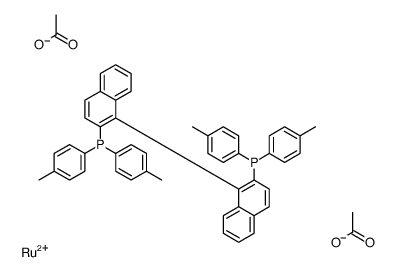116128-29-1
| Name | Ruthenium(2+) acetate 1,1'-binaphthalene-2,2'-diylbis[bis(4-methy lphenyl)phosphine] (1:2:1) |
|---|---|
| Synonyms |
Diacetato[(S)-(-)-2,2'-bis(di-p-tolylphosphino)-1,1'-binaphthyl]ruthenium(II)
(S)-Ru(OAc)2(T-BINAP) Ru(O2CMe)2((R)-tolBINAP) MFCD09753021 Ru(OAc)2((R)-Tol-BINAP) Ru(OCOCH3)2((R)-tol-binap) (R)-Ru(OAc)2(T-BINAP) |
| Molecular Formula | C52H46O4P2Ru |
|---|---|
| Molecular Weight | 897.93700 |
| Exact Mass | 898.19100 |
| PSA | 107.44000 |
| LogP | 7.92240 |
|
Section 1: Product Identification Chemical Name:Diacetato[(R)-(+)-2,2'-bis(di-p-tolylphosphino)-1,1'-binaphthyl]ruthenium(II) Ru(OAc)2[(R)-tolbinap] CAS Registry Number:116128-29-1 Formula:C52H46O4P2Ru EINECS Number:none Chemical Family:metal phosphine complex Synonym:[Ru(OAc)2{(R)-tolbinap}]
Section 2: Composition and Information on Ingredients IngredientCAS NumberPercentACGIH (TWA)OSHA (PEL) Title compound116128-29-1100%no datano data Section 3: Hazards Identification Emergency Overview:Irritating to skin, eyes and respiratory tract. Primary Routes of Exposure:Inhalation, skin, eyes Eye Contact:Causes slight to mild irritation of the eyes. Skin Contact:Causes irritation to the skin Inhalation:Causes irritation to the nose, mucous membranes and respiratory tract Ingestion:No information on the physiological effects of ingestion. May be harmful if swallowed. Acute Health Affects:Irritating to skin, eyes and respiratory tract. Chronic Health Affects:No information available on long-term chronic effects NTP:No IARC:No OSHA:No SECTION 4: First Aid Measures Immediately flush the eyes with copious amounts of water for at least 10-15 minutes. A victim may need Eye Exposure: assistance in keeping their eye lids open. Get immediate medical attention. Wash the affected area with water. Remove contaminated clothes if necessary. Seek medical assistance if Skin Exposure: irritation persists. Remove the victim to fresh air. Closely monitor the victim for signs of respiratory problems, such as difficulty Inhalation: in breathing, coughing, wheezing, or pain. In such cases seek immediate medical assistance. Seek medical attention immediately. Keep the victim calm. Give the victim water (only if conscious). Induce Ingestion: vomiting only if directed by medical personnel. SECTION 5: Fire Fighting Measures Flash Point:no data Autoignition Temperature:no data Explosion Limits:no data Extinguishing Medium:carbon dioxide, dry chemical or foam If this product is involved in a fire, fire fighters should be equipped with a NIOSH approved positive pressure Special Fire Fighting Procedures: self-contained breathing apparatus and full protective clothing. Hazardous Combustion andIf involved in a fire, this material may emit toxic organic fumes Decomposion Products: Unusual Fire or Explosion Hazards: No unusual fire or explosion hazards SECTION 6: Accidental Release Measures Small spills can be mixed with vermiculite, sodium carbonate or other suitable non-combustible adsorbent and Spill and Leak Procedures: swept up. SECTION 7: Handling and Storage Keep material in a tightly sealed container. Prolonged exposure to the air may result in degradation of the Handling and Storage: product. Handle and store material under an inert atmosphere of nitrogen or argon. SECTION 8: Exposure Controls and Personal Protection Eye Protection:Always wear approved safety glasses when handling a chemical substance in the laboratory. Skin Protection:Wear protective clothing and gloves. Ventilation:Handle the material in an efficient fume hood. If ventilation is not available a respirator should be worn. The use of respirators requires a Respirator Respirator: Protection Program to be in compliance with 29 CFR 1910.134. Ventilation:Handle the material in an efficient fume hood. Additional Protection:No additional protection required. SECTION 9: Physical and Chemical Properties Color and Form:brown powder Molecular Weight:897.94 Melting Point:>100° (decomp) Boiling Point:no data Vapor Pressure:no data Specific Gravity:no data Odor:not determined Solubility in Water:insoluble SECTION 10: Stability and Reactivity Stability:air sensitive Hazardous Polymerization:no hazardous polymerization Conditions to Avoid:contact with air Incompatibility:strong oxidizing agents Decomposition Products:carbon monoxide, carbon dioxide, phosphorous pentoxide, organic fumes and ruthenium salts. SECTION 11: Toxicological Information RTECS Data:No information available in the RTECS files Carcinogenic Effects:no data Mutagenic Effects:no data Tetratogenic Effects:no data SECTION 12: Ecological Information Ecological Information:No information available SECTION 13: Disposal Considerations Disposal:Dispose of according to local, state and federal regulations SECTION 14: Transportation Shipping Name (CFR):Non-hazardous Hazard Class (CFR):NA Additional Hazard Class (CFR):NA Packaging Group (CFR):NA UN ID Number (CFR):NA Shipping Name (IATA):Non-hazardous Hazard Class (IATA):NA Additional Hazard Class (IATA):NA Packaging Group (IATA):NA UN ID Number (IATA):NA SECTION 15: Regulatory Information TSCA:Not listed in the TSCA inventory SARA (Title 313):Title compound not listed Second Ingredient:none SECTION 16 - ADDITIONAL INFORMATION N/A |
| RIDADR | NONH for all modes of transport |
|---|
